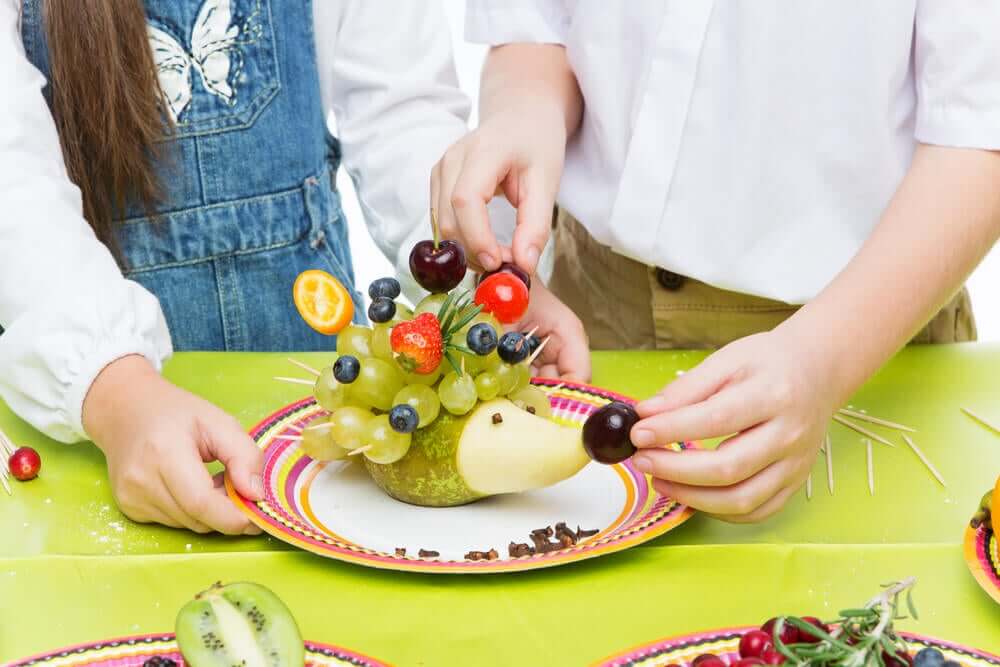Weekly Menu for Children from 6 to 12 Years Old


Written and verified by the nutritionist Saúl Sánchez Arias
If you want to maintain a healthy diet at home, it’s important to consider planning a weekly menu for children. During childhood, it’s essential to ensure an optimal supply of nutrients to promote the growth and development of the little ones. Otherwise, some physiological functions could be affected and thus increase the risk of suffering from a disease in the medium term.
At the same time, it’s key to instill good dietary habits during the first stages of life. This way, it is easier to maintain them in the future and also reduces the chances of having to deal with the food rejections that are so common at this age.
Next, we’ll tell you everything you need to know to start changing your children’s eating routine today. Take note!
What should a weekly menu for children between 6 and 12 years old contain?
One of the main aspects to consider when planning a weekly menu is the protein intake of their diet. This is to satisfy the demands of this growth stage without incurring excesses.
According to a study published in the Annals of Nutrition & Metabolism, during childhood, it’s important to increase the consumption of proteins, as they’re essential nutrients for physical growth. Likewise, they play a very important role in maintaining homeostasis (balance) of the internal environment.
At least half of the proteins in a child’s diet must be of high biological value, that is, of animal origin. Ideally, they should be consumed accompanied by a good handful of cis-type fatty acids, such as the omega 3 present in oily fish.
Carbohydrates are also decisive at this stage, although in most cases, the contribution is usually sufficient. The key here is to prioritize complex type sugars and cut down on simple ones, such as those used to sweeten beverages and foods.
As for vitamins and minerals, there are usually deficiencies. In this sense, it’s best to increase the sources of vitamin C in the diet, as this element has been shown to enhance the function of the immune system.
Another essential vitamin is vitamin D, and it can be obtained from food (bluefish, dairy products, and eggs) or from regular sun exposure.

Example of weekly children’s menu
Next, we’re going to share with you an example of a weekly menu for children between 6 and 12 years old. This doesn’t mean that adaptations can’t be made according to individual preferences, as the most important thing is to try to personalize it to achieve better adherence. Take note!
Monday
- Breakfast: Toast with sliced tomato and turkey. One serving of fruit
- Mid-morning: A handful of nuts
- Lunch: Baked chicken with sweet potato and broccoli
- Snack: Yogurt with a couple of ounces of dark chocolate
- Dinner: Turkey sautéed with vegetables and curry
Tuesday
- Breakfast: Oatmeal
- Mid-morning: Natural yogurt
- Lunch: Grilled salmon with peppers and quinoa
- Snack: Fruit and a slice of Serrano ham
- Dinner: Scrambled eggs with mushrooms
Wednesday
- Breakfast: Toast with avocado and turkey
- Mid-morning: A portion of fruit
- Lunch: Vegetable salad with fresh cheese
- Snack: Oatmeal pancakes with peanut butter
- Dinner: Grilled fish with peppers and mushrooms
Thursday
- Breakfast: Cream cheese beaten with oatmeal and nuts
- Mid-morning: A handful of peanuts
- Lunch: Quinoa with tuna and vegetables
- Snack: Fruit
- Dinner: Sautéed minced meat and vegetables
Friday
- Breakfast: Toast with peanut butter and banana
- Mid-morning: Yogurt with almonds
- Lunch: Grilled fish with beans and cooked potato
- Snack: Dark chocolate and cheese
- Dinner: Grilled eggs with quinoa and crushed tomato
Saturday
- Breakfast: Yogurt with nuts and pineapple
- Mid-morning: Piece of fruit
- Lunch: Rice with vegetables
- Snack: Yogurt
- Dinner: French omelette stuffed with spinach
Sunday
- Breakfast: Oatmeal muffin with fruit
- Mid-morning: Yogurt
- Lunch: Minced meat and vegetable fajitas
- Snack: Dark chocolate
- Dinner: Salad with canned tuna and fresh cheese

Try following an optimal weekly menu for children
As you’ve seen, it’s easy to prepare a weekly children’s menu that ensures a supply of high-quality nutrients. Therefore, healthy growth and adequate development can be achieved so that children can perform well at school and during sports.
In any case, variations can be made to adapt the diet to the tastes of each young person. This is a key factor in ensuring adherence and continuity.
Finally, remember that you need to promote other healthy lifestyle habits, such as a good night’s rest. Children at this age should get at least 8 hours of sleep each night and maintain a quality rest. To do this, they must go to bed early and reduce the use of screens in the hours before sleep.
If you want to maintain a healthy diet at home, it’s important to consider planning a weekly menu for children. During childhood, it’s essential to ensure an optimal supply of nutrients to promote the growth and development of the little ones. Otherwise, some physiological functions could be affected and thus increase the risk of suffering from a disease in the medium term.
At the same time, it’s key to instill good dietary habits during the first stages of life. This way, it is easier to maintain them in the future and also reduces the chances of having to deal with the food rejections that are so common at this age.
Next, we’ll tell you everything you need to know to start changing your children’s eating routine today. Take note!
What should a weekly menu for children between 6 and 12 years old contain?
One of the main aspects to consider when planning a weekly menu is the protein intake of their diet. This is to satisfy the demands of this growth stage without incurring excesses.
According to a study published in the Annals of Nutrition & Metabolism, during childhood, it’s important to increase the consumption of proteins, as they’re essential nutrients for physical growth. Likewise, they play a very important role in maintaining homeostasis (balance) of the internal environment.
At least half of the proteins in a child’s diet must be of high biological value, that is, of animal origin. Ideally, they should be consumed accompanied by a good handful of cis-type fatty acids, such as the omega 3 present in oily fish.
Carbohydrates are also decisive at this stage, although in most cases, the contribution is usually sufficient. The key here is to prioritize complex type sugars and cut down on simple ones, such as those used to sweeten beverages and foods.
As for vitamins and minerals, there are usually deficiencies. In this sense, it’s best to increase the sources of vitamin C in the diet, as this element has been shown to enhance the function of the immune system.
Another essential vitamin is vitamin D, and it can be obtained from food (bluefish, dairy products, and eggs) or from regular sun exposure.

Example of weekly children’s menu
Next, we’re going to share with you an example of a weekly menu for children between 6 and 12 years old. This doesn’t mean that adaptations can’t be made according to individual preferences, as the most important thing is to try to personalize it to achieve better adherence. Take note!
Monday
- Breakfast: Toast with sliced tomato and turkey. One serving of fruit
- Mid-morning: A handful of nuts
- Lunch: Baked chicken with sweet potato and broccoli
- Snack: Yogurt with a couple of ounces of dark chocolate
- Dinner: Turkey sautéed with vegetables and curry
Tuesday
- Breakfast: Oatmeal
- Mid-morning: Natural yogurt
- Lunch: Grilled salmon with peppers and quinoa
- Snack: Fruit and a slice of Serrano ham
- Dinner: Scrambled eggs with mushrooms
Wednesday
- Breakfast: Toast with avocado and turkey
- Mid-morning: A portion of fruit
- Lunch: Vegetable salad with fresh cheese
- Snack: Oatmeal pancakes with peanut butter
- Dinner: Grilled fish with peppers and mushrooms
Thursday
- Breakfast: Cream cheese beaten with oatmeal and nuts
- Mid-morning: A handful of peanuts
- Lunch: Quinoa with tuna and vegetables
- Snack: Fruit
- Dinner: Sautéed minced meat and vegetables
Friday
- Breakfast: Toast with peanut butter and banana
- Mid-morning: Yogurt with almonds
- Lunch: Grilled fish with beans and cooked potato
- Snack: Dark chocolate and cheese
- Dinner: Grilled eggs with quinoa and crushed tomato
Saturday
- Breakfast: Yogurt with nuts and pineapple
- Mid-morning: Piece of fruit
- Lunch: Rice with vegetables
- Snack: Yogurt
- Dinner: French omelette stuffed with spinach
Sunday
- Breakfast: Oatmeal muffin with fruit
- Mid-morning: Yogurt
- Lunch: Minced meat and vegetable fajitas
- Snack: Dark chocolate
- Dinner: Salad with canned tuna and fresh cheese

Try following an optimal weekly menu for children
As you’ve seen, it’s easy to prepare a weekly children’s menu that ensures a supply of high-quality nutrients. Therefore, healthy growth and adequate development can be achieved so that children can perform well at school and during sports.
In any case, variations can be made to adapt the diet to the tastes of each young person. This is a key factor in ensuring adherence and continuity.
Finally, remember that you need to promote other healthy lifestyle habits, such as a good night’s rest. Children at this age should get at least 8 hours of sleep each night and maintain a quality rest. To do this, they must go to bed early and reduce the use of screens in the hours before sleep.
All cited sources were thoroughly reviewed by our team to ensure their quality, reliability, currency, and validity. The bibliography of this article was considered reliable and of academic or scientific accuracy.
- British Nutrition Foundation. Children. Noviembre 2015.
- Carr, A. C., & Maggini, S. (2017). Vitamin C and Immune Function. Nutrients, 9(11), 1211. Disponible en: https://doi.org/10.3390/nu9111211
- Health Kids Association. Vitamins and minerals.
- NHS. How many calories dies child of 7 to 10 need? Servicio Nacional de Salud de Escocia. Agosto 2021.
- NHS Foundation Trust. Healthy eating for 6-12 years old. West Suffolk National Health Service.
- Richter, M., Baerlocher, K., Bauer, J. M., Elmadfa, I., Heseker, H., Leschik-Bonnet, E., Stangl, G., Volkert, D., Stehle, P., & on behalf of the German Nutrition Society (DGE) (2019). Revised Reference Values for the Intake of Protein. Annals of nutrition & metabolism, 74(3), 242–250. Disponible en: https://doi.org/10.1159/000499374
- Stanford Medicine Children’s Health. School-aged child nutrition.
This text is provided for informational purposes only and does not replace consultation with a professional. If in doubt, consult your specialist.








